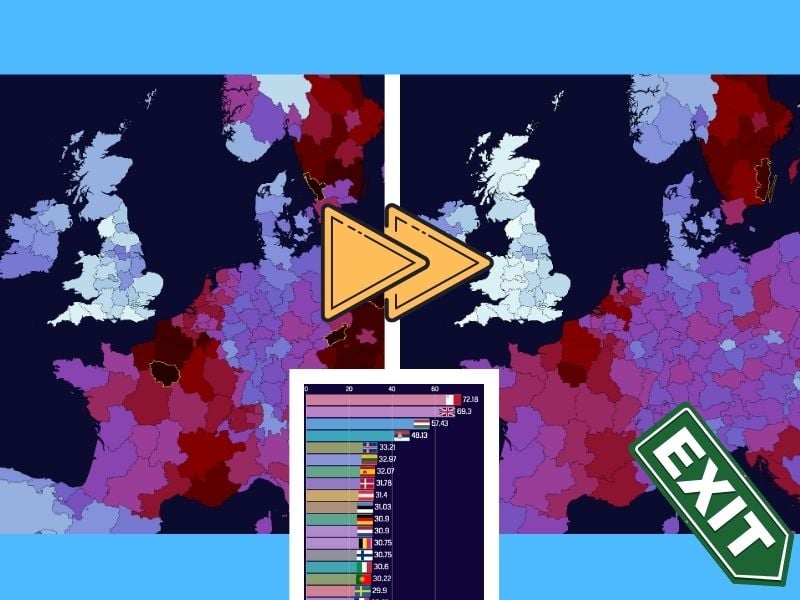
Is the long-drawn-out corona marathon in its final sprint here in Europe? It’s beginning to look more and more like it. Whereas the British and Portuguese were the first to introduce a relaxation of the rules at the beginning of this month, locks are now being cast off in almost all countries. The Italians can frequent sidewalk cafes again, vaccinated Danes are allowed back inside almost everywhere and the reviled curfew in the Netherlands has been consigned to the history books.
But how are ‘we’ doing and when will we be rid of these hassles? That’s what this weekly column tries to answer using data gathered from three areas: Infection rates, (changes in) corona rules and vaccination rates. We use maps, interactive visualizations and motion graphics to also make this rather complex pandemic subject matter understandable to the layperson.
Last week, the focus was on the gamble on a good outcome. This week, we look ahead towards a very exciting new month. To get the “sour note” out of the way immediately, we will kick off this week with infection rates. The slide chart below shows the number of infections from the last week of April next to the chart from the end of March.
Dying flame or smouldering peat fire?
The largest corona hotspots outside of Sweden in the past seven days were the regions around Paris, Cyprus, Croatia and the south of the Netherlands. For the least amount of viral threat, you had to be in the Faroe Islands this week. That’s where only one unlucky person tested positive after taking a nasal swab.
Especially in Central Europe, people are breathing a sigh of relief after the lockdowns have seemed to pay off. Is the third wave on its way out? In some places it certainly is, but by no means everywhere. This becomes even clearer with the interactive heatmap below. A cautionary note?
Apparently, lockdowns in the Czech Republic and Poland lead to a much faster decline than they do in Western Europe, where similar policies have had much less dramatic results. The Netherlands even managed to see an uptick. Despite a curfew, closures of a wide range of public buildings and a whole list of insistent advisories that apparently were not being acted upon (by a long shot).
Lockdown index score
What exactly are governments doing to get corona under control? Everywhere is different. Sweden doesn’t consider a towering corona tsunami to be much of a problem. While Germany, on the other hand, has implemented a new set of very stringent measures. Every country has its own lockdown policy. You can see how the rules differ from country to country on the site of Re-open EU. If you have time to spare, and check back more often, you will notice that the rules change quite often. Particularly during this phase.
But because this site can be rather cluttered and data journalists like concrete numbers, the so-called lockdown index score was developed 14 days ago for this section. A ‘stringency score‘ of between 0 and 100 is calculated based on 22 closures, restrictions and measures. For an explanation of exactly how this score is calculated and what measures are taken into account, the Corona in Europe edition of two weeks ago offers more clarity.
Where is the most allowed and where is the least allowed? Finland retains its high freedom score, but the fact that many governments have started to relax the rules becomes clear when you see the scores of April 14 and 28 on the maps below.
Netherlands = Sweden?
Falling diagnosis rates seem to be the reason for Italy, Norway and Ireland to allow more freedoms. Because Angela Merkel did not see this trend reflected in her own country. It is only there that rules have been tightened. Germany is now the strictest with a score of 96 points. The Czech Republic and Belgium have thrown off comparatively the most locks over the past fourteen days.
The Netherlands clearly did not want to miss out on this relaxation party that is being thrown. Against the advice of the experts, a whole series of rules have been scrapped this week. With 32 points, the policy here is now comparable to that of Sweden, which also doesn’t care much for the dark colors on the corona maps. Relaxations were also pushed through at a faster pace than in Portugal, Denmark, the United Kingdom and Spain. A very bold or even rash gamble, when ICUs are almost full and while the impact of the vaccines is still some time away. But how long will this last?
After four full months of vaccination shots, the problems with the supply of vaccines have largely been resolved. This seems to have freed up space to vaccinate the population at full throttle. The fact that the pace has been stepped up in March and April can be seen at a glance in the race animation below that tracks the number of shots per 100 people per week.

The inoculation turning point
That Israel and the United Kingdom have their vaccination strategies in order is something that we all know by now. Yet these are no longer the only places where the threat of corona is disappearing like snow in the sun. In fact, the first two EU member states already seem to have bagged the prize.
On Wednesday, European shot champion Malta reported only 15 new infections. Not bad for the tiny island that has now even surpassed the British in the number of shots administered per 100 upper arms. But with a population of just half a million, this is going to be a little easier than anywhere else. In Hungary, a breakneck pace has been maintained for several months now with the help of Chinese and Russian vaccines.
A hasty rush is seldom a good thing? The figures claim exactly the opposite. On March 31, Hungary reported 15,988 new infections while yesterday the number stood at a scant 1,253, more than ten times lower. Such a steady decline cannot force a national confinement order. The only logical explanation: Vaccines work, and not too shabbily either.
Will it all be over by May?
The salvation effect of tens of millions of serums is expected to become a reality for the European squad over the course of the coming month. After more than a year of elbow greetings, one-and-a-half-meter distancing and being boring, the “speck on the horizon” is increasingly starting to take the shape of a pharmacy bottle.
Whereas the corona figures from Italy convinced me of impending doom in February 2020, the European data from fifteen months later paints a very rosy picture of the future that is, more importantly, within reach. Subject to the fact that double mutants from India don’t end up flipping the rules of the game once more. Or that premature parties don’t escalate things utterly unnecessarily within sight of the safe harbor.
Just a little more patience. We are almost there. Don’t do anything stupid.


